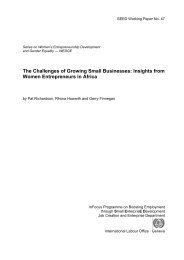manual: women workers' rights and gender equality - International ...
manual: women workers' rights and gender equality - International ...
manual: women workers' rights and gender equality - International ...
Create successful ePaper yourself
Turn your PDF publications into a flip-book with our unique Google optimized e-Paper software.
For the non-smoker:<br />
Environmental tobacco smoke contains the same carcinogens <strong>and</strong> toxic chemicals that smokers<br />
inhale. Exposure to environmental tobacco smoke increases the risk of cancer, heart diseases,<br />
strokes, emphysema, pulmonary infections <strong>and</strong> osteoporosis. There is no safe level of exposure to<br />
environmental tobacco smoke.<br />
At work:<br />
Tobacco smoke increases the risk of occupational diseases in coal mining, <strong>and</strong> working with<br />
pesticides, rubber <strong>and</strong> petroleum <strong>and</strong> cotton <strong>and</strong> wood dusts. Tobacco smoke aggravates the<br />
impact of asbestos, ethanol, silica, radiation, cadmium <strong>and</strong> arsenic. Smoking <strong>and</strong> exposure to<br />
environmental tobacco smoke have a negative impact on productivity <strong>and</strong> increase sick leave,<br />
insurance costs, accidents <strong>and</strong> risk of fire while decreasing worker morale.<br />
What measures can be taken to reduce the risk?<br />
Effective measures to reduce the risks of exposure to smoking are often at no or little cost <strong>and</strong> may<br />
include:<br />
• Obtaining information from local or national organizations about the dangers of smoking <strong>and</strong> of<br />
exposure to environmental tobacco smoke <strong>and</strong> distributing this information to all workers.<br />
• Elimination the exposure of non-smokers to environmental tobacco smoke.<br />
• Banning smoking at work<br />
• If necessary, identifying specific enclosed <strong>and</strong> separately ventilated areas where workers can<br />
go to smoke <strong>and</strong> to which non-smokers do not need access.<br />
Alcohol <strong>and</strong> drugs<br />
Alcohol <strong>and</strong> drugs – what is it?<br />
The use of alcohol <strong>and</strong> drugs can threaten the health <strong>and</strong> safety of workers, of co-workers, <strong>and</strong> of<br />
the general public. While certain work-related characteristics such as shift work, travel away from<br />
home <strong>and</strong> stress <strong>and</strong> boredom may increase the use of alcohol <strong>and</strong> drugs, the work culture <strong>and</strong><br />
availability of alcohol <strong>and</strong> drugs at work are also significant factors which can increase or decrease<br />
the use of these substances.<br />
Alcohol <strong>and</strong> drugs – who is at risk?<br />
Workers who use alcohol <strong>and</strong> drugs are at greater risk of health <strong>and</strong> safety problems at work <strong>and</strong><br />
at home. Co-workers <strong>and</strong> the general public who come into contact with a worker under influence<br />
of alcohol <strong>and</strong>/or drugs are also at increased risk of injury.<br />
Is the issue of alcohol <strong>and</strong> drugs a <strong>gender</strong> issue?<br />
While fewer <strong>women</strong> than men drink, <strong>women</strong> become more intoxicated than men after drinking the<br />
same amount of alcohol, even when differences in body weight are taken into account. In addition,<br />
chronic alcohol abuse takes a heavier physical toll on <strong>women</strong> than on men.<br />
What are the results of using alcohol <strong>and</strong>/or drugs at work?<br />
For the individual:<br />
The use of alcohol can cause liver damage, heart disease, certain forms of cancer, stomach<br />
ailments, diseases of the central nervous system <strong>and</strong> irreversible brain damage. The use of drugs<br />
can cause elevated heart rate <strong>and</strong> blood pressure, respiratory failure, convulsions, cardiovascular<br />
problems including strokes <strong>and</strong> heart attacks, certain forms of cancer <strong>and</strong> liver <strong>and</strong> kidney<br />
impairment. Alcohol <strong>and</strong> drugs can also decrease concentration <strong>and</strong> coordination <strong>and</strong> result in<br />
altered perceptions <strong>and</strong> emotions.<br />
154

















